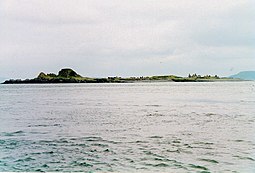| Scottish Gaelic name | Beul na h-Uamha |
|---|---|
| Meaning of name | The mouth of the cave |
 Belnahua from the south | |
| Location | |
| OS grid reference | NM713127 |
| Coordinates | 56°15′N 5°41′W / 56.25°N 5.69°W |
| Physical geography | |
| Island group | Slate Islands |
| Highest elevation | 22 m (72 ft) |
| Administration | |
| Council area | Argyll and Bute |
| Country | Scotland |
| Sovereign state | United Kingdom |
| Demographics | |
| Population | 0 |
| References | [1][2][3][4] |
Belnahua is one of the Slate Islands, in the Firth of Lorn in Scotland, known for its deserted slate quarries. The bedrock that underpins its human history is part of the Scarba Conglomerate Formation and its value has been on record since the 16th century.[5][6] Likely uninhabited before commercial quarrying commenced,[7] under the control of the Stevenson family during the 19th century[8] the population expanded to over 150[9] before the island was abandoned again in 1914.[10]
Living on a remote island in the 19th century came with significant hardships and the lives of the quarry workers have been described in unflattering terms by modern commentators, one describing them as in effect "slaves".[11] Today, the ruined buildings and abandoned machinery lie amidst the water filled quarries and are home only to wildlife.[12] There are very strong tidal streams in the area and this a potentially hazardous location for shipping. In 1936 the cargo vessel Helēna Faulbaums was wrecked on the island, with the loss of 15 lives.[13]
- ^ 2001 UK Census per List of islands of Scotland
- ^ Haswell-Smith (2004), p. 67.
- ^ Ordnance Survey. OS Maps Online (Map). 1:25,000. Leisure.
- ^ Iain Mac an Tailleir. "Placenames" (PDF). Pàrlamaid na h-Alba. Archived from the original (PDF) on 23 September 2011. Retrieved 28 July 2007.
- ^ Cite error: The named reference
Kilmartinwas invoked but never defined (see the help page). - ^ Monro (1549), 27.
- ^ Withall (2013), p. 5.
- ^ Pallister (2007), Slated.
- ^ Withall (2018), Early Days in the Easdale Practice.
- ^ Withall (2013), p. 11.
- ^ Murton (2017), p. 32.
- ^ Withall (2013), pp. 50, 69.
- ^ Baird (1995), p. 115.
